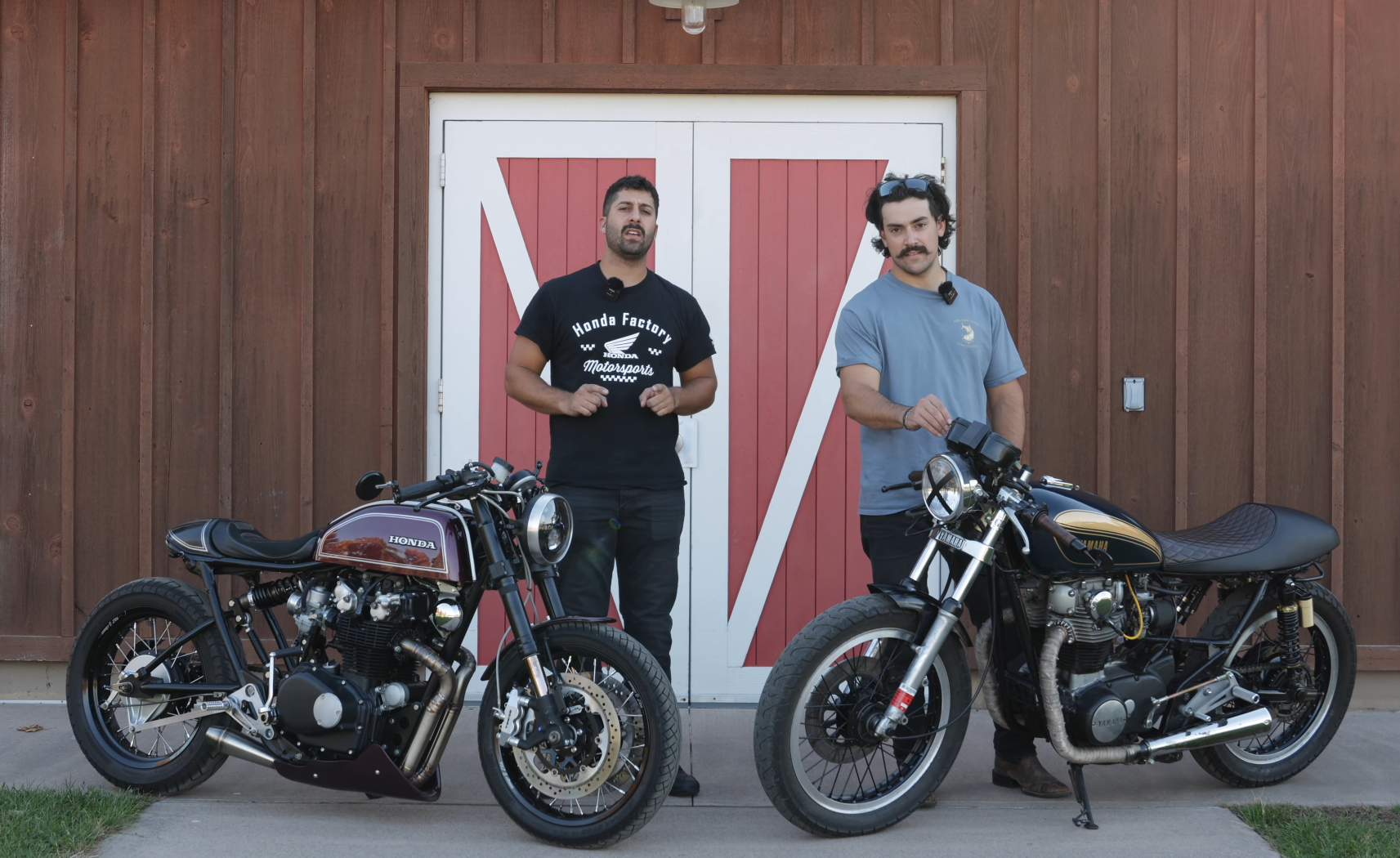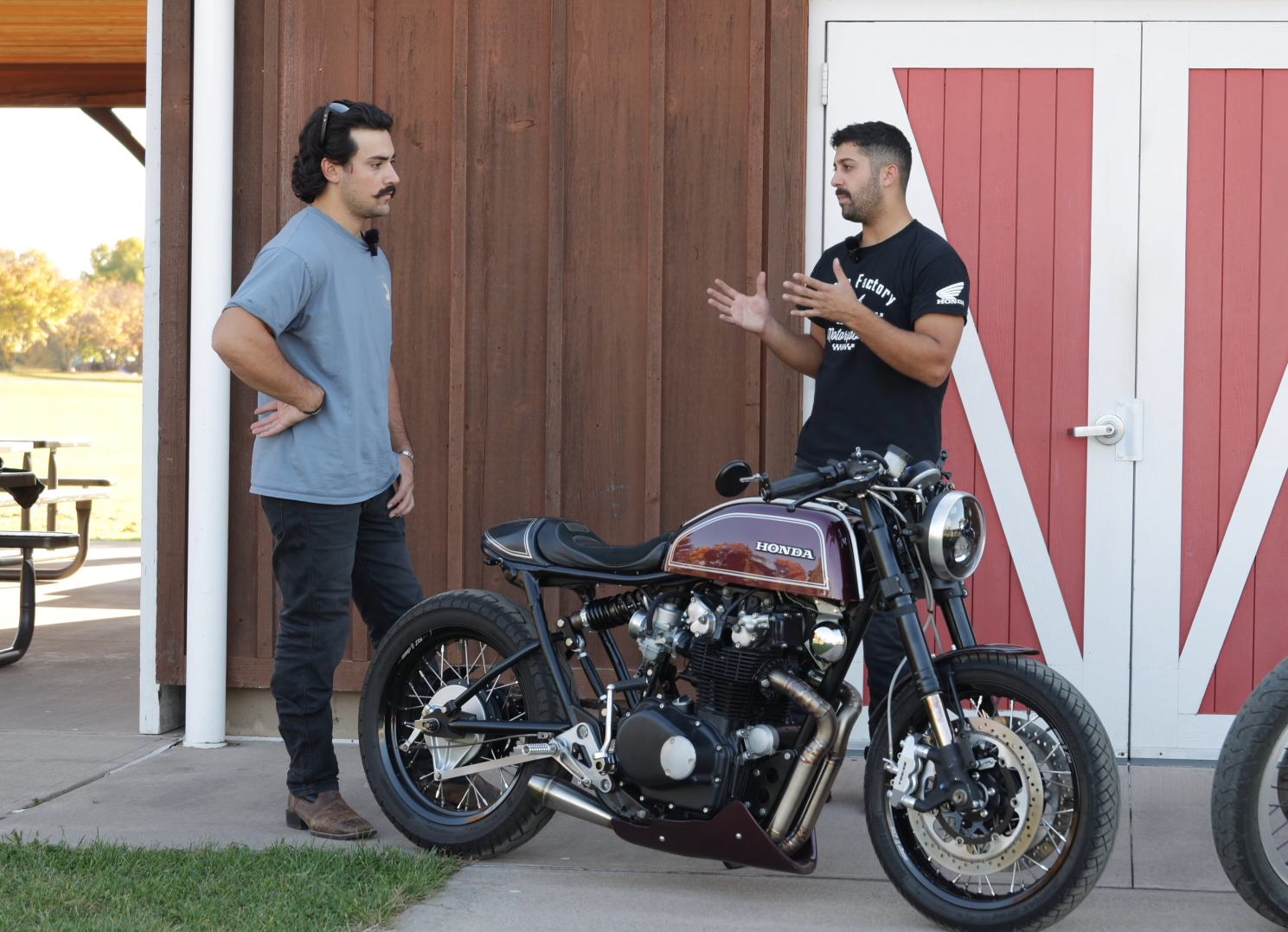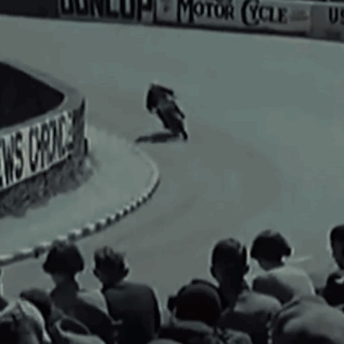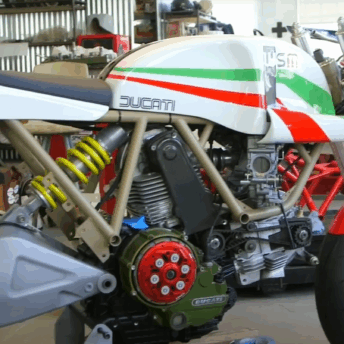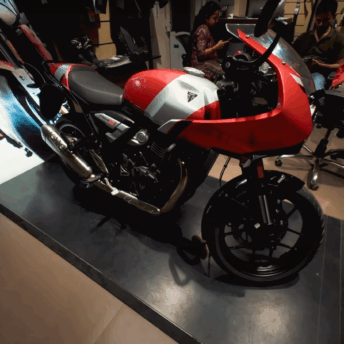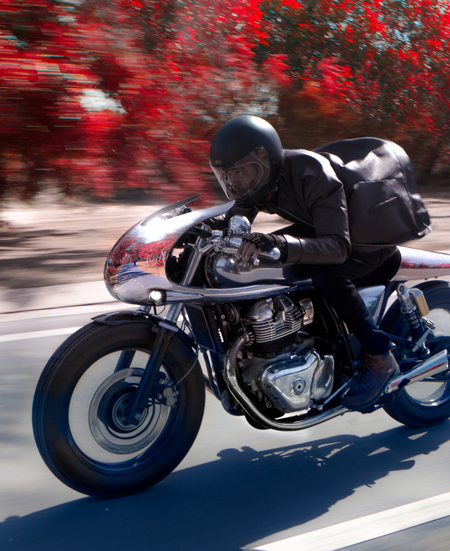When looking at a Cafe Racer, there are many ways to create a unique bike. Some builders choose to work with a modest budget, using affordable parts and simple changes. Others invest heavily, customizing nearly every detail for style and performance. Both approaches have their own value, and neither is right or wrong.
This article examines two Cafe Racers built with very different budgets: an affordably built Yamaha XS 650 and a fully customized Honda CB450. It covers important aspects such as comfort, costs, practical use, and long-term value. By comparing the strengths and weaknesses of each bike, readers can better understand which kind of build might suit their needs.
Key Takeaways
- There are big differences between budget and high-end Cafe Racers.
- Design choices affect comfort, cost, and daily use.
- Customization can increase value and fit personal goals.
Overview of the Cafe Racers
Custom Honda CB450 Club Sport by Mile Zero Builders
The Honda CB450, originally from 1974, was fully rebuilt and transformed by Mile Zero Builders. Every part, including the seat pan and rear hump, was custom-fit to match the rider’s height and weight. The seat’s design offers a snug, cockpit-like feel, keeping the rider firmly in place while riding. Clip-on handlebars were set above the top triple tree, giving a slightly higher riding position compared to other builds, though it still puts strain on the wrists.
Comfort Upgrades:
- Custom seat and hump for better grip
- Handlebars mounted higher for slight comfort
- Full GSXR front-end upgrade for extra stability
- Monoshock rear conversion, changing the bike’s frame geometry
Despite these upgrades, the CB450 is not made for comfort, but it is as comfortable as a cafe racer can be. On a 1–5 scale, it received a comfort rating of 2.5.
| Feature | Upgrade Type |
|---|---|
| Seat | Custom fit with rear hump |
| Handlebars | Clip-ons above triple tree |
| Front Suspension | GSXR front-end swap |
| Rear Suspension | Monoshock conversion |
| Foot Pegs | Rear set, custom brackets |
1977 Yamaha XS650 Low-Budget Project
This 1977 Yamaha XS650 started off as a completely stock motorcycle. Built on a tight budget, most modifications were practical and affordable. Simple clip-on handlebars from eBay replaced the stock ones, while rear-set foot pegs were adapted and installed. The seat was custom-shaped to fit the stock brackets and give the stylish “cafe hump”—though it left extra space behind the rider, making the design less functional.
Key Features:
- eBay clip-on handlebars
- Rear-set foot pegs from third-party supplier
- Stock brackets used for seat fitting
- Basic suspension refresh with budget shocks
Comfort was not a priority, and modifications sometimes made the ride less comfortable. This bike received a comfort rating of 1.2 out of 5.
Notable Modifications:
- Handlebars: Changed to low clip-ons
- Foot Pegs: Upgraded to rear sets
- Seat: Custom hump, but a non-ergonomic fit
- Suspension: Budget upgrades, focused on cost over performance
| Feature | Change Made |
|---|---|
| Handlebars | Low-budget clip-ons |
| Foot Pegs | Rear sets replaced stock |
| Seat | Custom but basic fit |
| Suspension | Affordable shock absorbers |
Philosophy Behind Design
Aims and Visual Choices
The main goal of a cafe racer is not comfort; instead, these bikes are about style and being lightweight for speed. Cafe racers focus on a classic look, often using low handlebars and custom seats. Both budget and expensive builds include changes such as clip-on handlebars, rear-set foot pegs, and minimal designs.
Some parts are added just for the “look,” even if they reduce comfort. For example:
- Clip-on handlebars from eBay (cheaper builds)
- Custom seat pans and humps (higher-end builds)
- Rear-set foot pegs (on both bikes)
Riders usually accept some discomfort to get the right appearance and essence.
Core Features of Cafe Racers
Most cafe racers share several main parts, whether they are built on a budget or are highly customized. These features include:
| Feature | Purpose |
|---|---|
| Straight lines | Creates a simple, clean shape |
| Low handlebars | Gives a tucked, aggressive riding style |
| Minimalist design | Cuts away extra weight or details |
| Custom seats | Fits the unique shape of each bike |
| Rear-set foot pegs | Supports the racing posture |
Even though the materials and finishing can vary, the list of essentials stays the same. Builders might add newer forks for more stability, or upgrade shocks, but the fundamental idea remains: to create a bike that is stripped-down, streamlined, and ready for fast riding. The design choices always put style and performance first, even if it means less comfort.
Analyzing Comfort
Riding Position and Feel
Both the high-end Honda CB450 Club Sport Light and the budget Yamaha XS650 focus on style and speed rather than comfort. Riders on both bikes need to lean forward because of the low handlebars and minimalist design. This position puts pressure on the wrists and provides a stiffer ride, which is typical for this type of motorcycle. Riders do not get the relaxed posture found on cruisers or touring bikes.
Modifications to Seats and Handlebars
The Yamaha XS650 uses clip-on handlebars from eBay, which actually reduce comfort compared to the stock setup. Rear-set foot pegs were added, making the ride more manageable for the intended style, but not improving comfort much. The seat is customized to fit the bike but is longer than needed, so the hump at the back does not offer full support.
On the Honda CB450, the seat pan and seat were made exactly to fit the rider’s height and weight, avoiding the extra slide found in the XS650’s seat. The hump at the back gives more of a cockpit feel, holding the rider in place. The clip-on handlebars on this bike are mounted above the top triple tree, giving a less aggressive forward lean than the XS650. Still, neither setup is considered comfortable for long rides.
Effects of Suspension and Bike Design
Both bikes have had changes to their suspension. The XS650 uses inexpensive rear shocks from eBay, which simply update the old stock parts without major performance gains. The CB450 features a full monoshock conversion and a GSXR front end for better front-end stability and a smoother ride. These changes improve handling and control but do not make a big difference in overall comfort, especially because custom setups can sometimes make the ride stiffer or more aggressive.
- XS650: Basic new shocks, not a major comfort upgrade.
- CB450: Custom monoshock and upgraded front forks for better stability but not much extra comfort.
Comfort Scores Side by Side
| Motorcycle | Comfort Score (out of 5) |
|---|---|
| Budget XS650 (Yamaha) | 1.2 |
| Custom CB450 (Honda) | 2.5 |
Both bikes score low on comfort. The custom-built Honda CB450 rates a bit higher due to its tailored seat and improved geometry, but neither bike is made for relaxed riding. Riders building or choosing a cafe racer should not expect high comfort levels, no matter the budget.
Detailed Cost Analysis
Expenses for Affordable Cafe Racer
The budget cafe racer is a 1977 Yamaha XS650, originally purchased for $1,000 in stock condition. All modifications were chosen for value and simplicity. Here is a breakdown of the major costs:
| Item | Source | Approx. Cost |
|---|---|---|
| Handlebars (clip-ons) | eBay | Low |
| Rear set foot pegs | TC Bros | Low – Moderate |
| Custom seat (stock brackets) | Custom fit | Low |
| Rear shocks | eBay | Low |
| Other small upgrades | Various | Variable |
| Total Build Cost | ~$3,000 |
The focus was on keeping expenses down, using affordable options like eBay parts and modifying original parts whenever possible. The total build was about three thousand dollars.
Investment for Premium Cafe Racer Custom
The higher-end build is a 1974 Honda CB450 known as the “Club Sport Light,” which was fully rebuilt and redesigned. This bike had a much larger investment, both in money and customization:
- Custom seat pan, seat, and rear hump made to fit specific rider dimensions.
- Clip-on handlebars mounted above the triple tree for a distinct, tailored setup.
- GSXR front-end swap to improve stability and ride feel.
- Monoshock rear conversion, involving new geometry and heavy fabrication.
- Custom rear set brackets and foot pegs for a better riding position.
Parts were chosen for quality and performance, and some modifications required advanced tools and skills. The overall costs were much higher than the budget bike, with significant investment in both parts and labor. The exact total is not specified, but it is clear this build required a large financial commitment compared to the budget approach.
Everyday Practical Use
Both the budget Yamaha XS650 and the custom Honda CB450 Club Sport Light have certain challenges when it comes to daily usability. They share many of the usual features you’ll find on most café racers, such as low handlebars, rear-set foot pegs, and a focus on style rather than daily comfort or convenience.
Key Practical Features:
- Minimal Storage: Neither bike provides built-in space to carry items, which limits options for errands or commuting.
- Seating: The custom seats are shaped for the cafe racer style and rider position, not for long rides or carrying passengers.
- Handlebars: Both bikes use clip-ons, which can tire out wrists and backs quickly, especially during city rides or traffic.
- Suspension: The budget bike uses basic shocks from eBay, while the custom build has an advanced monoshock setup. Both improve the ride a bit compared to the original, but neither matches the smoothness of modern bikes.
Comparison Table:
| Feature | Budget XS650 | Custom CB450 Club Sport Light |
|---|---|---|
| Seat Comfort | ★☆☆☆☆ (1.2/5) | ★★☆☆☆ (2.5/5) |
| Storage | None | None |
| Suspension | Basic (eBay) | Advanced (Monoshock) |
| Riding Posture | Aggressive | Aggressive |
| Passenger Friendly | No | No |
For everyday riding, neither bike is designed to be practical. Both focus on lightweight parts, strong style, and a vintage riding feel rather than modern amenities. Basic tasks, like commuting or grocery runs, may be less convenient compared to other motorcycle types. However, for those who value the unique look and riding experience, these bikes deliver what they promise.
Value Over Time and Smart Spending
Forecasting Sale Price
When looking at the future worth of these bikes, there are things to keep in mind. The budget Yamaha XS650 build, done by a high schooler, started as a totally original 1977 bike. After upgrades like eBay clip-ons and a custom seat, its value might go up for some buyers, but it generally stays closer to the original cost plus simple improvements. People looking for basic cafe racers or classic bikes may find these budget builds appealing due to the lower price.
The more expensive Honda CB450 Club Sport Lite, built by M Zero Racers, has had a full rebuild with many custom features. This level of craftsmanship and unique parts can often help maintain or even boost the bike’s resale value compared to a stock or simply modified bike. Attention to details like custom seats and tailored ergonomics can attract serious buyers or collectors looking for something special.
Here’s a quick table that compares key points:
| Bike | Budget XS650 | Club Sport Lite CB450 |
|---|---|---|
| Starting Condition | Stock, original | Full rebuild, custom |
| Major Upgrades | Clip-ons, rear sets, seat | Custom seat, monoshock, more |
| Potential Resale Audience | Regular riders, beginners | Collectors, enthusiasts |
| Possible Value Change | Moderate, tied to upgrades | High, custom work matters |
Care and Ongoing Costs
How much you spend on repairs and care can make a big difference over years of ownership. The Yamaha XS650 budget build used simple and cheap parts, like eBay shocks and DIY fittings. This means upkeep is easier and often less expensive, but it may need more frequent attention or replacements since cheaper parts might wear out sooner.
On the CB450 custom build, much of the maintenance relies on the quality and uniqueness of the components. Custom work like monoshock conversions and a GSXR front end can be smoother and more stable, but finding the right replacement parts, or fixing things if they break, might cost more and take longer. High-quality parts may last longer, but the more complex the build, the more skills and money might be needed to keep it in top shape.
A quick breakdown in list form:
- Budget Build:
- Uses standard, easy-to-find parts
- Lower upfront and routine costs
- Might need more fixes over time
- High-End Build:
- Custom and sometimes rare components
- Higher maintenance costs
- Quality and uniqueness can lead to better long-term stability
Taking care of these bikes is important, whether you’re riding daily or showing them at events. The type of parts and work done early on affects what you’ll need to do, and spend, in the future.
Key Comparisons and Final Thoughts
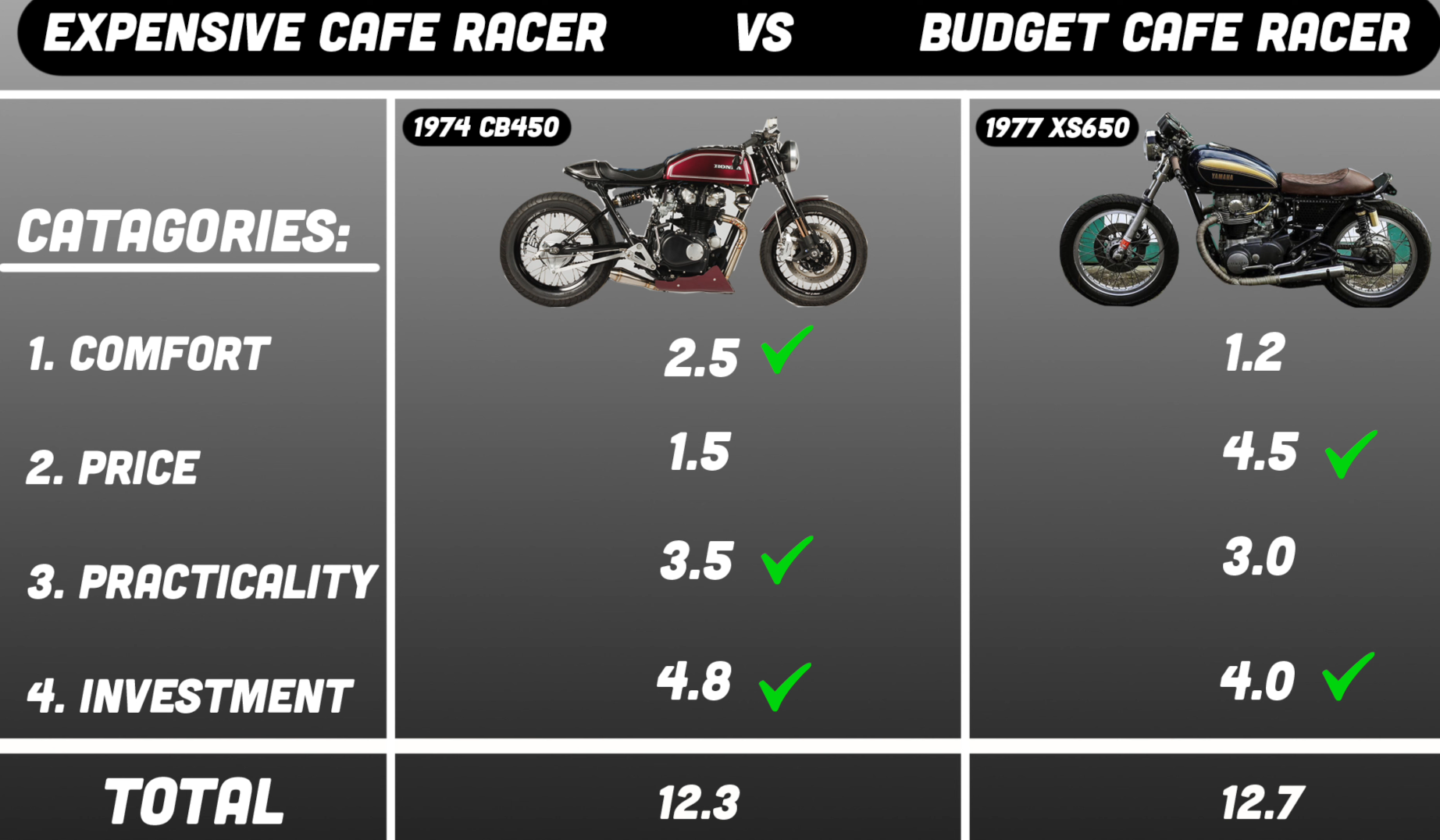

When comparing the two Cafe Racers—the affordable Yamaha XS 650 and the high-end Honda CB450 Club Sport Light—several important differences and similarities stand out across comfort, customization, and costs.
Comfort Ratings
| Motorcycle | Comfort Score (1-5 Scale) |
|---|---|
| Budget Yamaha XS 650 | 1.2 |
| Premium Honda CB450 CSL | 2.5 |
Both bikes keep the classic Cafe Racer style. Neither is designed with comfort as the main goal.
Key Points:
- The Yamaha XS 650 had simple upgrades such as eBay handlebars and budget rear shocks. The seat was custom-shaped to fit but gave too much room, so it did not hold the rider in place as well as hoped.
- The Honda CB450 CSL had more advanced custom work for a better fit. The seat, rear hump, and riding position were designed specifically to match the rider’s size. Handlebars were higher, and the front end had a GSXR swap for increased stability.
- Despite the extra work and better components, neither bike achieved a high comfort rating. The Honda did slightly better, mainly because of the personalized fit and upgraded suspension.
Modification and Design Elements
- Both builds followed core Cafe Racer themes: low handlebars, stripped-down frames, lightweight design, and rear-set foot pegs.
- The Yamaha’s upgrades focused on affordable parts to change the look and handling.
- The Honda’s build emphasized unique solutions, such as a one-off seat, Monoshock conversion, and curated geometry settings for performance and rider fit.
Cost Differences
- The budget Yamaha XS 650 had a purchase price of $1,000.
- Total spending for the Yamaha after modifications stayed much lower than the Honda build, which included many labor-intensive, high-end custom elements.
Summary Table:
| Aspect | Yamaha XS 650 (Budget) | Honda CB450 CSL (Premium) |
|---|---|---|
| Comfort Rating | 1.2 | 2.5 |
| Approach | Basic, affordable mods | Custom, high-end build |
| Suspension | Budget eBay shocks | Full GSXR front, Monoshock |
| Seat | Extended, simple fit | Fully custom, cockpit focus |
| Purchase Price | $1,000 | Much higher |
These side-by-side details show that while spending more can allow for custom work and small gains in comfort, the essential ride feel and style priorities of a Cafe Racer remain similar—even on very different budgets. Choices in parts, labor, and design make each bike unique, but some characteristics are shared in the Cafe Racer world.
